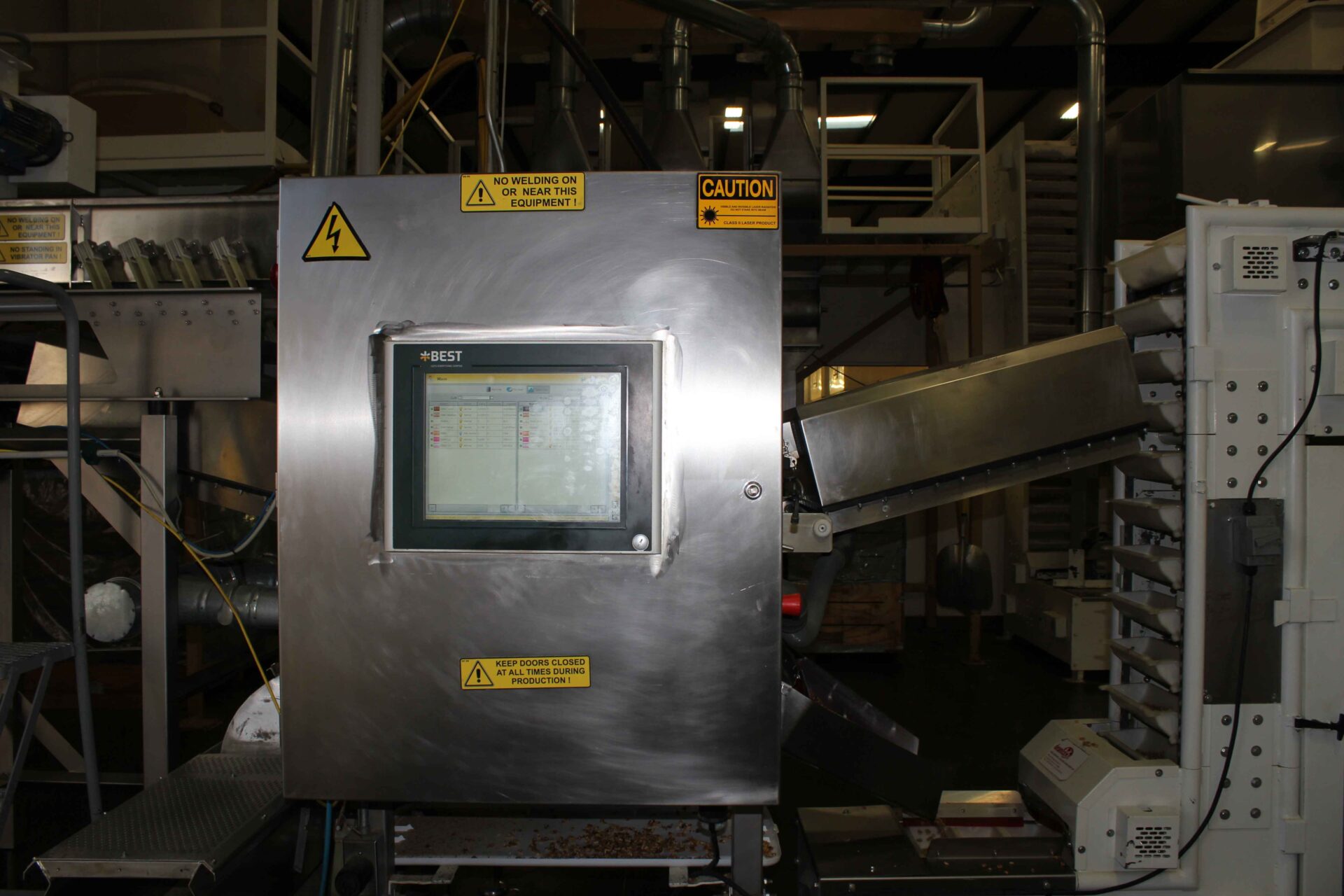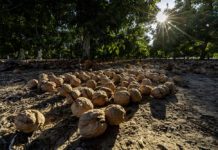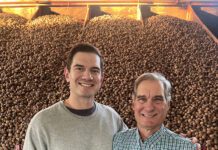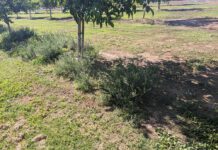A wet harvest is a concern for many walnut growers. Will I have a home for my nuts or will I be left out in the cold?
A major motivation for growers to move into hulling is ensuring their own nuts, according to Bill Carriere, president of Carrier Family Farms in Glenn, California. Carriere farms have been hulling walnuts since 1974.
Installing a huller is a big capital outlay, Carriere continued. “Some of it is basically just insurance that you have a home for your walnuts at the time you want it.”
Individual Versus Commercial
Roger Isom, CEO of the Western Agricultural Processors Association (WAPA) said, the first thing to consider is are you doing just your own nuts, or are you going to do a commercial operation that includes your nuts and other growers?
With a Commercial operation size alone comes with more problems, Isom said.
- More energy usage
- More permitting, depending the location
- More labor issues
Carriere said he thinks the bigger the better to a certain degree, just because of the economy of scale.
“There are hullers out there that have very little of their own production. They’re strictly a custom operation, but that’s unique,” Carriere said.
“We used to say if you had 300-500 acres you could build a huller, and run it yourself, and bring in a few outside growers,” Carriere said, but today his gut feeling is that more acreage may be needed to make it pencil out.
“In the old days, it was very common to see a huller just for the grower and doing his own. Most of the installations I see going in today, if they’re going to the expense of building a huller, it’s for multiple growers,” Isom said, adding the only way to make it pencil out is with a commercial operation.
“You’ve got to run it 45, if not 60 days, and put a lot of nuts through it to help pay for that capital expenditure that you’re putting out,” Isom said.
Carriere said that a huller is a huge investment that will only be in operation for a month and a half maybe, and at capacity for three weeks.
“The rest of the time it’s going to sit there and rust,” Carriere said.
“We’ve looked into a lot of other options on how to utilize the equipment or the building,” Carriere said, but in the end, nothing else really worked for us.
Alan Reiff, Owner of Wizard Manufacturing Inc. in Chico, California, agreed the majority of growers take this step for the sake of control.
“It really smoothes out your harvest practices when you have your own processing facility,” Reiff said.
Spread out the Harvest
Another reason to have other growers is to spread out the harvest, Carriere said.
It’s also important to have earlier varieties, not just later varieties like Chandlers, Carriere continued.
“If you have your own production, you can get more control. For example, we spray quite a bit of Ethephon (used to accelerate hull cracking and separation from the shell) on our own production so that we bring it in early. So, when the rush hits, we’re kind of done with ours, or at least well into it. And then some orchards we don’t spray, and we try to keep them for last just to spread that window out as much as possible,” Carriere said.
Installing a huller/dryer is a decent investment, and with a properly sized facility the initial investment, including interest, can be recouped in seven to eight years, Reiff said.
It’s important not to over size them or under size them, because then it’s not a good investment, Reiff said. And the longer the huller/dryer is in operation, the sooner the investment is recouped.
“Typically, the reason you can run it longer is not more products, but more varieties,” Reiff said.
With just one variety, it’s a 14 day season, but with two or three varieties it can be up to a 28 day season, Reiff said.
Labor
When a grower is running a farming operation, a lot of the work is contracted out for everything from pruning to harvest, Isom said.
“When you’re talking about running a huller or dehydrator, now all of the sudden you’ve got full time employees,” Isom said.
And this change means:
- Personnel policies—what do those policies mean
- A lower overtime trigger—these employees can’t be worked like they were in the orchards
- Sexual harassment policy
- Finding competent employees
As labor becomes tighter and tighter, finding labor is difficult, but there is also competition from neighboring farms, Isom said.
You may offer $12 an hour, but the grower down the street is paying $12.50 an hour, so you may have to increase wages just to get employees, Isom said.
“Along with that, your labor pool is shrinking. You might be taking people that probably aren’t the first ones you’d want to hire,” Isom said.
“So, what does that mean?” Isom asks.
It could mean you’ll have a higher potential for more accidents, Isom said.
“We’ve seen a whole host of issues with people that you probably would have passed on before, but because the labor pool is small, you’ll take whoever you can get. And so that’s a huge issue,” Isom said.
“Hiring temp labor to come in to do some of the major jobs at a huller is problematic, unless they just randomly have that experience,” Carriere said.
“You can hire sorters, you can hire people to sweep, you can hire somebody to shovel something, or pick up sticks, or whatever, but bringing somebody in to run the huller, he needs to be one of your permanent employee in my opinion,” Carriere said.
Planning
Carrier also recommends planning ahead because the companies that build the huller are generally booked out a long way in advance.
“If we want to add significant parts or pieces of equipment to our hulling operation, we definitely need to let them know earlier rather than later,” Carriere said.
Between designing and permits you want to be at least 18 months out, Carriere said.
“It’s all planning. The nice part about what we’ve talked about here a lot is, when you plant an orchard, assuming you did your preplanning there as well, now you have four years before that kicks in with significant volume,” Carriere said, adding this gives you time to plan your huller.
Carriere said, we continue to plan. We know how many trees are in the ground and how much production is expected off of those non-bearing trees.
We also track what we’re going to tear out or replace, and then we talk to all of our growers and ask how many acres they planted last year, and if they are planning on bringing them to us and what variety, Carriere said.
“We try to plan all that,” Carriere said.
Inspections
Running a huller brings a lot more scrutiny than would potentially be seen on the farm, Isom said.
There will be inspections, and depending on where the huller is located, there will be inspections from:
- The air district
- The California Department of Food and Agriculture (CDFA) as part of the Food Safety Modernization Act (FSMA)
- The Department of Labor or Cal/OSHA (Division of Occupational Safety and Health) if there is an accident or complaint
“Typically, if you’re only doing your own, all those same things apply,” Isom said, but you’re probably not as big an operation, so you don’t need as many people, and it is less likely that some of these things will occur.
“If you’re commercially doing outside product, there’s no doubt you’re going to need an air pollution permit, whichever county you may be in,” Isom said.
The Sacramento Valley is probably less onerous than San Joaquin Valley, or the Yolo/Solano Air Quality Management districts where there’s a lot of scrutiny, Isom said.
Automation
Automation does raise costs initially, but with things like wages, overtime, and worker’s compensation, Isom thinks that automation may be the answer.
“I think people are willing to spend a little more money now for increased automation to avoid the (labor) issues,” Isom said.
Isom uses robotic sorters as an example. Initially, the technology wasn’t quite there, but it’s pretty much mastered now, and one company has replaced 32 people with two machines that cost a $1 million each.
The company estimates it will pay back that expenditure in three years with the savings from salary, sick leave, overtime, and workers compensation, Isom said.
Carriere agreed that more and more automation is the future. “Strictly from the labor perspective, if not for accuracy,” he said.
Equipment upgrades are not cheap, Carriere said, but one thing we do is rent our camera sorter.
“They (the company) come and get it after harvest, and take it back, and give it all the software upgrades, and bring it back right before harvest and reinstall it,” Carriere said.
“The direction is toward more and more technology to minimize labor and human error,” Reiff said.
Reiff said, growers are investing in redundant color sorting systems and eliminating all human hand sort labor. They’re also investing in automated bin filling and automated dryer controls to eliminate the need for labor to fill bins and monitor moisture content.
Do the Math
Isom advised growers before making this investment to do the math, not just short term, but into the future.
“You can’t look at just the year ahead. You’ve got to be looking five-10 years down the road before you make that investment,” Isom said.
















